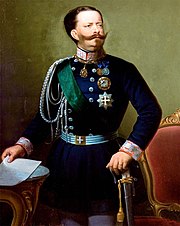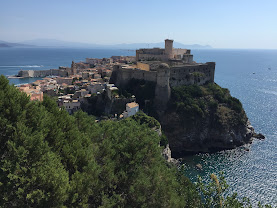NEW - Pope Pius IX
Pontiff who regarded himself as a prisoner
Pope Pius IX, who died on this day in 1878 in the Apostolic Palace in Vatican City in Rome, had the longest verified papal reign in history, having been head of the Catholic Church since 1846. He is also remembered for permanently losing control of the Papal States, which became part of the Kingdom of Italy in 1870. Afterwards he refused to leave Vatican City and often referred to himself as ‘a prisoner of the Vatican’. Pius IX was born Giovanni Maria Mastai Ferretti in 1792 in Senigallia in Le Marche which was then part of the Papal States. While studying theology, Mastai Ferretti met Pope Pius VII when he was visiting his hometown and afterwards, he entered the Papal Noble Guard. He was dismissed after he suffered an epileptic seizure, but Pius VII supported him continuing with his theological studies and he was ordained a priest in 1819. Pope Leo X chose him to support the Apostolic Nunzio on a mission to Chile and although it ended in failure the Pope gave him new roles and appointed him Archbishop of Spoleto in 1827, where he gained the reputation of being both efficient and liberal. Read more…
__________________________________________________________
Little Tony – pop singer
Star from San Marino enjoyed a long career
Singer and actor Little Tony was born Antonio Ciacci on this day in 1941 in Tivoli near Rome. His parents were both born in the Republic of San Marino and so Little Tony was Sammarinese and never applied for Italian citizenship. He became successful in the late 1950s and early 1960s in Britain as the lead singer of Little Tony and His Brothers. He had formed a group with his brothers, Alberto and Enrico, in 1957, calling himself Little Tony after the singer, Little Richard. The brothers were signed up by a record company, who released their versions of a series of American songs in Italy. After being invited to appear on a British TV show, they released their first single in the UK , I can’t help it, which was their 11th in Italy. Their third single, Too Good, reached No 19 in the UK singles chart in 1960. The group returned to Italy to appear at the Sanremo Festival where they came second. Then Little Tony began working as a solo singer and film actor. His hit song Cuore matto - Crazy Heart - was number one for nine consecutive weeks in 1967. In 1975 he recorded an album Tony canta Elvis - Tony Sings Elvis - paying tribute to Elvis Presley. Read more…
__________________________________________________________
The Bonfire of the Vanities
Preacher Savonarola's war on Renaissance 'excesses'
The most famous 'bonfire of the vanities' encouraged by the outspoken Dominican priest Girolamo Savonarola took place in Florence on this day in 1497. Savonarola campaigned against what he considered to be the artistic and social excesses of the Renaissance, preaching with fanatical passion against any material possession that might tempt the owner towards sin. He became notorious for organising large communal bonfires in the tradition of San Bernardino of Siena, urging Florentines to come forward with items of luxury or vanity or even simply entertainment that might draw them away from their faith. Savonarola arrived in Florence from his home town of Ferrara in 1482, entering the convent of St Mark. With Lorenzo de' Medici at the height of his power, Savonarola became disturbed by what he perceived as the moral collapse of the Catholic church. For a number of years he confined himself to speaking about repentance to congregations of believers in the parishes around Florence but on returning to the city in 1490 he began to campaign with more vigour about what he saw as the need for a return to piety. Read more…
_________________________________________________________
Amedeo Guillet – army officer
Superb horseman helped keep the British at bay
Amedeo Guillet, the last man to lead a cavalry charge against the British Army, was born on this day in 1909 in Piacenza. His daring actions in Eritrea in 1941 were remembered by some British soldiers as ‘the most frightening and extraordinary’ episode of the Second World War. It had seemed as though the British invasion of Mussolini’s East African empire was going like clockwork. But at daybreak on January 21, 250 horsemen erupted through the morning mist at Keru, galloping straight towards British headquarters and the artillery of the Surrey and Sussex Yeomanry. Red Italian grenades that looked like cricket balls exploded among the defenders and the guns that had been pointing towards Italian fortifications had to be quickly turned to face a new enemy. The horsemen later disappeared into the network of wadis - ravines - that crisscrossed the Sudan-Eritrean lowlands. Guillet’s actions at Keru helped the Italian army regroup and go on to launch their best actions in the entire war. Guillet was to live on until the age of 101 and become one of the most decorated people in Italian history. Read more…
________________________________________________________
Vittoria della Rovere – Grand Duchess of Tuscany
Bride who brought the treasures of Urbino to Florence
Vittoria della Rovere, who became Grand Duchess of Tuscany, was born on this day in 1622 in the Ducal Palace of Urbino. Her marriage to Ferdinando II de’ Medici was to bring a wealth of treasures to the Medici family, which can still be seen today in the Palazzo Pitti and the Uffizi Gallery in Florence. Vittoria was the only child of Federico Ubaldo della Rovere, the son of the Duke of Urbino, Francesco Maria. Her mother was Claudia de’ Medici, a sister of Cosimo II de’ Medici. As a child it was expected that Vittoria would one day inherit the Duchy of Urbino, but Pope Urban VIII convinced Francesco Maria to leave it to the Papacy and the Duchy was eventually annexed to the Papal States. Instead, at the age of nine, Vittoria received the Duchies of Rovere and Montefeltro and an art collection. Vittoria had been betrothed to her Medici cousin, Ferdinando, since the age of one and was sent by her mother to be brought up at the Tuscan court. The marriage was arranged by Ferdinando’s grandmother, Christina of Lorraine, who had been acting as joint regent of the Duchy with Ferdinando’s mother, Maria Maddalena of Austria. Read more…



















